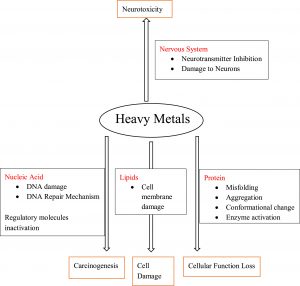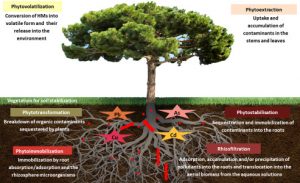Implementation of Phytoremediation in Heavy Metal Pollution
Written by: Anisha Kolambe
Since the arrival of the industrial era in the 18th century, pollution and climate have become matters of increasing concern. Although metals are naturally found on earth’s crust, anthropogenic (human-caused) activity has increased the concentrations of various heavy metals exposed to the environment, thus posing a threat to ecology due to the effects of biomagnification (the concentration of contaminants accumulate within organisms when consumed, and are thus found in increasing levels ascending the food chain). Additionally, compounds present in the soil may spread to aquatic environments due to runoff, emphasizing the importance of managing metal pollution. Phytoremediation – the use of plants to reduce toxic effects – is a cost effective and promising method for preventing the interference of heavy metals in the food web.
The Implications of Heavy Metal Pollution
Heavy metal (HM) pollution is denoted by the environmental presence of heavy metals categorized by atomic mass and chemical properties in higher concentrations than the deemed permissible limit. It is often caused by human sources like mining, smelting, metal-based industrial activity, and leaching from areas such as waste dumps and landfills. Secondary sources are mainly agricultural, which includes the application of insecticides, pesticides, and fertilizers (Briffa et al., 2020). Arsenic, mercury, cadmium, cobalt, chromium, copper, lead, nickel, and zinc are the most common heavy metals that impact the environment (Kumar, 2021; Lambert et al.).
Heavy metals pose a dire threat to the natural ecosystem because they do not undergo biodegradation, but rather transform into alternate oxidation states (Kumar, 2021), react with other elements, and/or degrade into more toxic forms (Briffa et al., 2020). These effects occur because metalloids typically form covalent bonds, allowing them to bind to organic compounds and form lipophilic ions which attach to the nonmetal components in cellular macromolecules, causing toxic effects (Briffa et al., 2020). The bioaccumulation of these molecules can lead to disruptions in normal biochemical and physiological functions in both plants and animals (Kumar, 2021; Briffa et al., 2020). In plants specifically, the extended exposure to heavy metals can result in cellular damage from oxidative burst, interference with the sulfhydryl groups of biomolecules, interference at binding sites, and the inactivation of enzymes (Kumar, 2021). Additionally, HM pollution alters the quality of the soil in terms of pH, natural chemistry, porosity, and color (Briffa et al., 2020) and can also contribute to both water and air pollution, making it a serious danger to agricultural productivity and food security across the world.
Figure 1

The effects of heavy metals on different pathways, relative to human exposure.
Source: ScienceDirect (Briffa et al., 2020).
Areas affected by HM pollution are often categorized by the absence of life, except for metal-tolerant vegetation. Furthermore, these effects can spread since wind and rain have the potential to carry soil particles away from the initial site, contaminating surrounding areas. Metals especially bind more readily to soil that has higher clay content, more organic matter, and a basic pH (Briffa et al., 2020). Although on-site treatment methods of HM pollution exist, many of them are destructive and expensive to implement. Capping, for instance, involves adding an impermeable layer of material topped with soil above the contaminated site, preventing the absorption of metals by plant roots and contamination of groundwater (Briffa et al., 2020). Other procedures include excavation – the physical removal of soil to another location – and stabilization –reducing the bioavailability of metals by adding chemicals that transform it into a less toxic structure. However, both methods have their own risks especially since the metals are left in their original form, continuing the possibility of contaminating other site locations (Lambert et al.).
Types of Phytoremediation
Among the available methods of dealing with HM pollution, phytoremediation is gaining importance due to its low cost, non-intrusive procedure, and flexibility in approach. There are different branches of phytoremediation depending on the type of plant utilized and the surrounding qualities of the environment. Phytoimmobolization prevents the mobilization of metals in plant roots through HCO3-, thus avoiding food chain contamination. The utilization of metal tolerant plants to prevent the erosion of contaminants is described as phytostabilization, which centralizes the metals around the roots to allow for the concentrations in surrounding soil to decrease and thus maintain a stable ecosystem (Kumar, 2021; Lambert et al.). While both of these methods mainly focus on the transport of metals relative to the surrounding habitat, phytotransformation actually breaks down metals via metabolic processes or enzyme conversions, similar to microbial degradation. Rhizofiltration is a similar process, but centers more around the absorption and storage of metals rather than their conversion, especially from aqueous solutions (Kumar, 2021). While phytoextraction also removes contaminants through uptake from roots, the metals actually transfer to the shoots of the plant – the ‘above-ground’ biomass– due to the inherent detoxification of hyperaccumulating plants. Finally in phytovolatilization, pollutants convert to less toxic forms from transpiration from foliage (Kumar, 2021). The different types of phytoremediation are not necessarily exclusive to one another; however, it is difficult to identify an ideal individual plant capable of all potential aspects.
Figure 2

A diagram illustrating the different techniques of phytoremediation.
Source: ScienceDirect (Kumar, 2021).
Utilization of Biotechnology
Especially since plant species differ by environment and capability, genetic engineering is being explored as a viable option for raising the efficiency of phytoremediation techniques. Research into bacterial genes that allow for the conversion of heavy metals are particularly of interest in improving the tolerance of HM uptake, transport, and detoxification (Kumar, 2021). Although results of initial studies appear promising, the use of genetic modification requires careful consideration of unintended effects regarding genetic variability and food chain contamination. Additionally, the possibility for ethical and biosafety issues warrants the need for regulation by the government. Overall, biotechnology introduces new and improved ways of dealing with HM pollution that are non-intrusive and relatively cheaper compared to other alternatives.
Conclusion
Industrialization has brought many conveniences to everyday life, along with hidden consequences that are not always recognized. Heavy metal pollution presents a significant danger both to the health of a naturally functioning ecosystem and the human population. However, with the enforcement of proper mitigation strategies, the contamination of the surrounding environment can be limited through novel and eco-friendly techniques such as phytoremediation, which are being advanced through the development of new technology and action-promoting awareness in the modern world.
References and Sources
Briffa, J., Sinagra, E., & Blundell, R. (2020, September 8). Heavy metal pollution in the environment and their toxicological effects on humans. Retrieved February 18, 2022, from https://www.sciencedirect.com/science/article/pii/S2405844020315346#:~:text=Heavy%20metal%20pollution%20has%20emerged,excretion%2C%20livestock%20and%20chicken%20manure%2C.
Kumar, S. (2021). Chapter 12 – Aspects of Genetically Modified Plants in Removing Heavy Metals From the Soil. In Policy Issues in Genetically Modified Crops (pp. 273–289). essay, Academic Press. Retrieved February 18, 2022, from https://www.sciencedirect.com/science/article/pii/B9780128207802000121.
Lambert, M., Leven, B. A., & Green, R. M. (n.d.). New Methods of Cleaning Up Heavy Metal in Soils and Water. United States Environmental Protection Agency. Retrieved February 18, 2022, from https://cfpub.epa.gov/ncer_abstracts/index.cfm/fuseaction/display.files/fileID/14295